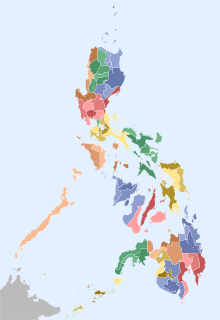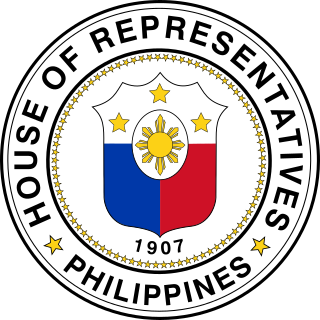
The provinces of the Philippines are the primary political and administrative divisions of the Philippines. There are 81 provinces at present, further subdivided into component cities and municipalities. The local government units in the National Capital Region, as well as independent cities, are independent of any provincial government. Each province is governed by an elected legislature called the Sangguniang Panlalawigan and an elected governor.

The House of Representatives of the Philippines is the lower house of the Congress of the Philippines. It is commonly referred to as Congress and informally referred to as the Cámara or Kamara.

The Second Congress of the Philippines was the meeting of the legislature of the Republic of the Philippines, composed of the Philippine Senate and House of Representatives from December 30, 1949, until December 8, 1953.
The legislative district of Baguio is the representation of the highly urbanized city of Baguio in the various national legislatures of the Philippines. The city is currently represented in the lower house of the Congress of the Philippines through its lone congressional district.
The legislative district of Benguet is the representation of the province of Benguet in the various national legislatures of the Philippines. The province is currently represented in the lower house of the Congress of the Philippines through its lone congressional district.
The legislative district of Ifugao is the representation of the province of Ifugao in the various national legislatures of the Philippines. The province is currently represented in the lower house of the Congress of the Philippines through its lone congressional district.
The legislative district of Mountain Province is the representation of Mountain Province in the various national legislatures of the Philippines. The province is currently represented in the lower house of the Congress of the Philippines through its lone congressional district.
The legislative districts of Sulu are the representations of the province of Sulu in the various national legislatures of the Philippines. The province is currently represented in the lower house of the Congress of the Philippines through its first and second congressional districts.
The legislative district of Davao del Sur is the representation of the province of Davao del Sur in the various national legislatures of the Philippines. The province is currently represented in the lower house of the Congress of the Philippines through its lone congressional district.
The legislative districts of Davao Oriental are the representations of the province of Davao Oriental in the various national legislatures of the Philippines. The province is currently represented in the lower house of the Congress of the Philippines through its first and second congressional districts.
The legislative district of Davao was the representation of the historical province of Davao in the various national legislatures of the Philippines until its dissolution in 1967.
The legislative districts of Cotabato are the representations of the province of Cotabato in the various national legislatures of the Philippines. The province is currently represented in the lower house of the Congress of the Philippines through its first, second, and third congressional districts.
The legislative district of Lanao was the representation of the historical province of Lanao in the various national legislatures of the Philippines until 1969. Marawi and Iligan also remained part of the province's representation even after becoming chartered cities in 1940 and 1950, respectively.
The legislative district of Surigao was the representation of the historical province of Surigao in the various national legislatures of the Philippines until the election of representatives for its successor provinces in 1961. The undivided province's representation encompassed the present-day provinces of Surigao del Norte, Surigao del Sur and Dinagat Islands.
The legislative districts of Misamis were the representations of the historical province of Misamis in the various national legislatures of the Philippines until 1931. The undivided province's representation encompassed what are now the provinces of Camiguin, Misamis Occidental and Misamis Oriental, and the highly urbanized city of Cagayan de Oro.
The legislative district of Occidental Mindoro is the representation of the province of Occidental Mindoro in the various national legislatures of the Philippines. The province is currently represented in the lower house of the Congress of the Philippines through its lone congressional district.
The legislative districts of Oriental Mindoro are the representations of the province of Oriental Mindoro in the various national legislatures of the Philippines. The province is currently represented in the lower house of the Congress of the Philippines through its first and second congressional districts.
The legislative districts of Misamis Occidental are the representations of the province of Misamis Occidental in the various national legislatures of the Philippines. The province is currently represented in the lower house of the Congress of the Philippines through its first and second congressional districts.
The legislative districts of Misamis Oriental are the representations of the province of Misamis Oriental in the various national legislatures of the Philippines. The province is currently represented in the lower house of the Congress of the Philippines through its first and second congressional districts.
Mindoro's at-large congressional district was the lone congressional district of the Philippines in the historical province of Mindoro for various national legislatures before 1952. The former province elected its representatives province-wide at-large from its reorganization under Article 6 of the Decreto de 18 junio de 1898 y las instrucciones sobre el régimen de las provincias y pueblos for the Malolos Congress in 1898 until its dissolution in 1952 into the present provinces of Occidental Mindoro and Oriental Mindoro. It was a single-member district throughout the ten legislatures of the Insular Government of the Philippine Islands from 1907 to 1935, the three legislatures of the Philippine Commonwealth from 1935 to 1946, and the first two congresses of the Third Philippine Republic from 1946 to 1952.



